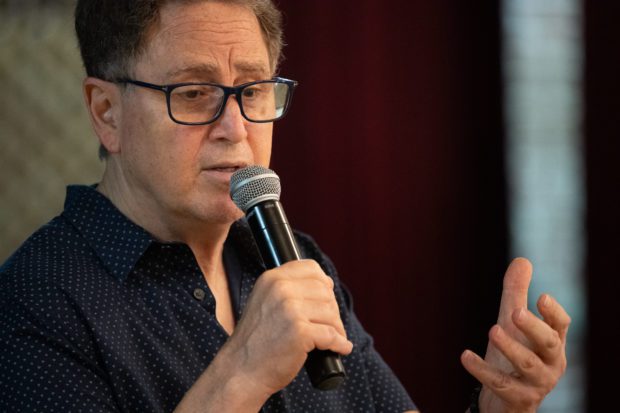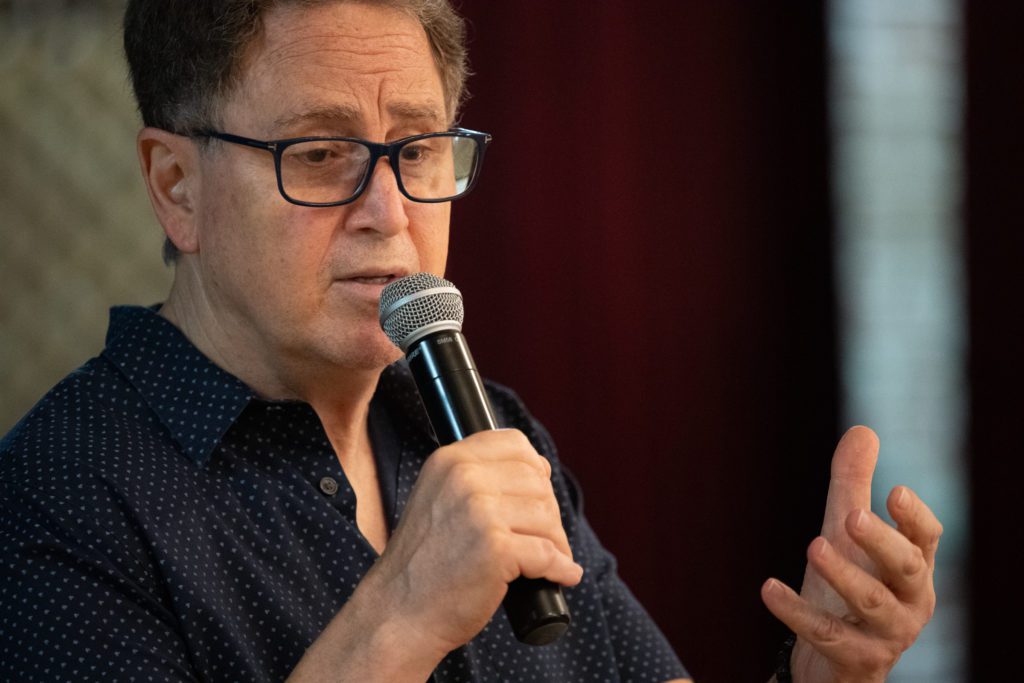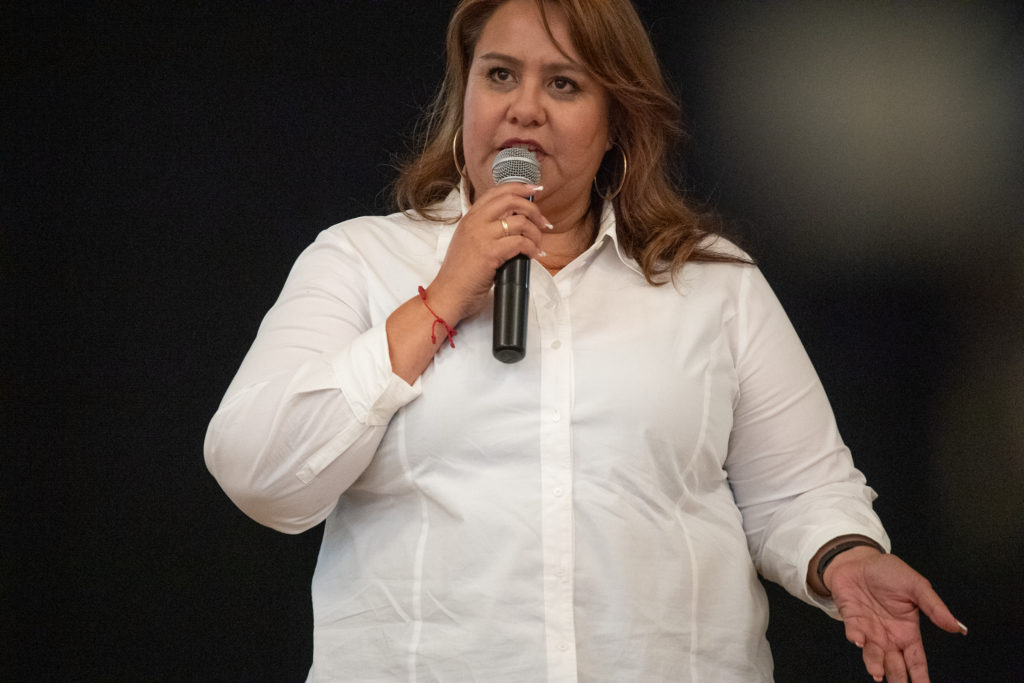

There are few places this year where water has been more of a preoccupation than in Kings County. That’s mainly because of a partial rewatering of the historic Tulare Lake, along with flooding due to a historic series of atmospheric river storms. While the national media has been obsessed with the Tulare Lake aspect, Kings County’s residents, farmers and public officials have been dealing with consequences on the ground.
This winter’s dramatic climate events, and the promise of more in the future, inspired the Kings County Democratic Party to sponsor a Water Town Hall in Hanford on June 16. The event brought together Kings County Supervisor Doug Verboon and several local experts who are working firsthand on water and agricultural matters. Pulling it all together was author and investigative journalist Mark Arax, who gave a wide-ranging talk weaving together a tapestry of Valley history, economics and politics.
Verboon comes from a farming family going back generations in Kings County and is a 13-year member of the county’s Board of Supervisors (BOS). He reported on the struggle lasting 11 years to rein in the export of groundwater to Southern California water agencies.
Action was spurred when billionaire farming giant John Vidovich built an expansive pipeline that sparked fears that it would enable him to sell groundwater. Last year, Verboon reported, the BOS achieved at least partial success when the supervisors adopted a water export ordinance. Verboon asserted that the county’s $2.3 billion agriculture industry requires the county to protect groundwater resources for dry years ahead.
Another urgent episode involved the community of Allensworth, which is notable for its historic stature as a state historic park representing the first African American–founded town in the state. Less known close by is the actual town of Allensworth with around 600 souls. When mid-March floodwaters from swollen rivers threatened evacuation, residents stayed and fought hard to save their homes.
That story was told by Valerie Jasso Gorospe and Frank Herrera. Gorospe is communications director for the Allensworth Progressive Association, a civic fundraising and planning group. She described the desperate hours trying to inform residents and acquire any help they could from any agencies they could contact.
Meanwhile, Herrera expressed a sense of dire emergency as Allensworth residents took matters into their own hands in a race against time and surging water. That experience, he concludes, underscores that they, and everyone, need to be ready for the next time, especially as El Niño is at our doorstep, emphasizing the need to effectively coordinate local, county and state officials.

Equitable access to water is an essential human rights concern in the San Joaquin Valley. Many thousands of Valley households, especially those in rural or unincorporated places, have only tainted tap water to drink, or their wells have gone dry. The problem is widespread still, notwithstanding that the Human Right to Water is law in California.
Fortunately, groups like the Community Water Center and Self-Help Enterprises are active in helping families and small towns to connect with state money and services. Jessie Snyder, veteran organizer with Self-Help Enterprises, said that there is now a lot of money available for water projects from state and federal sources. However, there are also challenges because of the fractured jurisdiction of water-governing agencies.
Governing water is an ages-old snarl in the Valley. Dan O’Connell made a case for untying the knot with greater inclusion into decision-making venues for those who are impacted but whose voices are not often heard. O’Connell, representing the Central Valley Partnership, a coalition offering a progressive and more just water policy, stated the need for a new narrative in water governance—one that includes previously underserved populations being involved in water decisions that affect their lives.
Citing the imminent threat of a wet-dry climate whiplash future, O’Connell warned, “This ecological crisis is occurring within longstanding, seemingly endemic social, racial and economic problems unique to the San Joaquin Valley.”
With a sweeping Valley overview, Arax wrapped up the event with the observation that what makes the Valley so abundant and verdant is that rivers run through it. For decades, Arax has plowed the rich soil of the San Joaquin for a bounty of deeply told stories about the land and its people.
He has brought his research and storytelling prowess to bear in works like The Dreamt Land: Chasing Water and Dust Across California, which paints a richly detailed picture of the Valley, and The King of California: J.G. Boswell and the Making of a Secret American Empire, a thorough and riveting history of the Boswell farming enterprise that to this day casts a wide shadow in Kings County.
Describing the cornucopia of farm goods due to the region’s benign climate primed with rivers of fresh water, Arax envisioned a more balanced approach to the Valley’s future.
“It makes sense to turn this land into food. We haven’t exactly turned it into food. We’ve turned it into nuts and fruits and some salads and things like that.
“But let’s make an argument for this ground to not be subdivisions, to not be mini malls, to be agriculture that is environmentally sustainable and in a human rights way, sustainable too. And that’s what we’re kind of all trying to achieve. It’s taken us a century and a half of extraction to get to where we’re at.”
He compared the small-farm, small-town dominated east Valley to the industrialized vastness of the west side with its sparsely populated mega-farmland. This farmland was created by the Central Valley Project with its iconic California Aqueduct moving water from northern watersheds down along the spine of the Valley.
“When you don’t live on your land, you have a kind of psychic distance from that land that allows you to be detached from it somehow. And that’s where the debate happens. Does it make sense for us to have spent this huge amount of money and infrastructure to grow farmland in places where nature didn’t intend it to grow?”
Zooming in closer to home, Arax traced the origins of today’s landscape, “What was done in the Tulare Lake Basin really has few parallels in American history, if not world history. They took the flow of those rivers and started siphoning it.
“And then when Boswell arrived in 1920, immediately they started thinking of a dam on all those rivers. And it took them 25, 30 years, but they dammed them too.”
Taming rivers was only the beginning, as Arax emphasized, “They took the hog wallows of the Valley and flattened them with the Fresno scraper, and we turned desert and marsh into the most industrialized farm belt in the world.
“It’s an extraordinary act. It’s an act of a lot of things. It’s an act of will. It’s an act of power. It’s an act of hubris, arrogance. It’s an act of defiance. It’s an act of greed. It’s an act of ambition. It’s an act of capitalism.”
There have always been dairies in the Valley. But not the massive cow factories that now spread across the Valley with the outsized impact on air and water quality coming from their effluence and methane. That happened after Southern California dairy operators sold out to real estate developers and moved into Valley counties with no questions asked or any concern over what the environmental consequences might be.
Arax pressed that hot button as well: “Along these rivers that feed Tulare Lake, there are mega-dairies galore. Dairies are the single biggest polluter, and I know this is sacrilege. We’re in Hanford, and I’m talking about dairies.
“But dairies are the single biggest polluter of the ground and the air in this valley. And we’re not regulating dairies when it comes to air pollution.”
Although the challenges facing the San Joaquin Valley are multifaceted and serious, Arax expressed hope that we can meet them, and in closing pointed out how his own work has been inspired by the work of groups like those at the town hall, “Some of those people are heroes and heroines of mine who educated me about what they are seeing in the Valley and given me a new set of eyes.”
For the rest of us, Arax advised, “Let’s keep telling stories. Let’s keep figuring this place out.”

